Analytical Thinking and Decision Making
VerifiedAdded on 2023/06/03
|17
|4620
|307
AI Summary
This article discusses the importance of decision making in organisations and how it affects their future. It analyzes the decision making process through SMART technique and heuristics. The article also includes a case study on Jacobi Consulting and their waste management technique. The value tree analysis and direct ranking of attributes are discussed in detail.
Contribute Materials
Your contribution can guide someone’s learning journey. Share your
documents today.
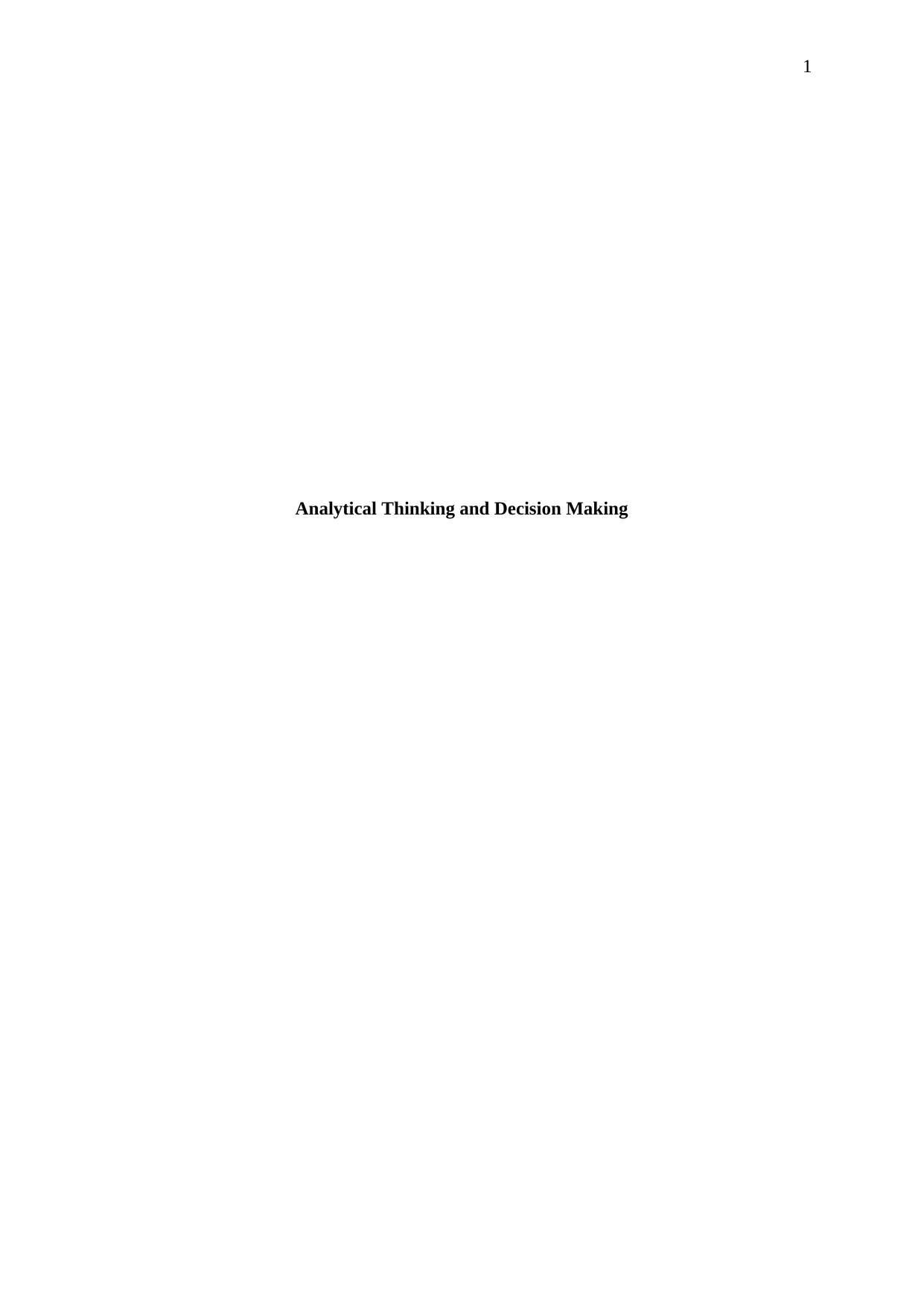
1
Analytical Thinking and Decision Making
Analytical Thinking and Decision Making
Secure Best Marks with AI Grader
Need help grading? Try our AI Grader for instant feedback on your assignments.
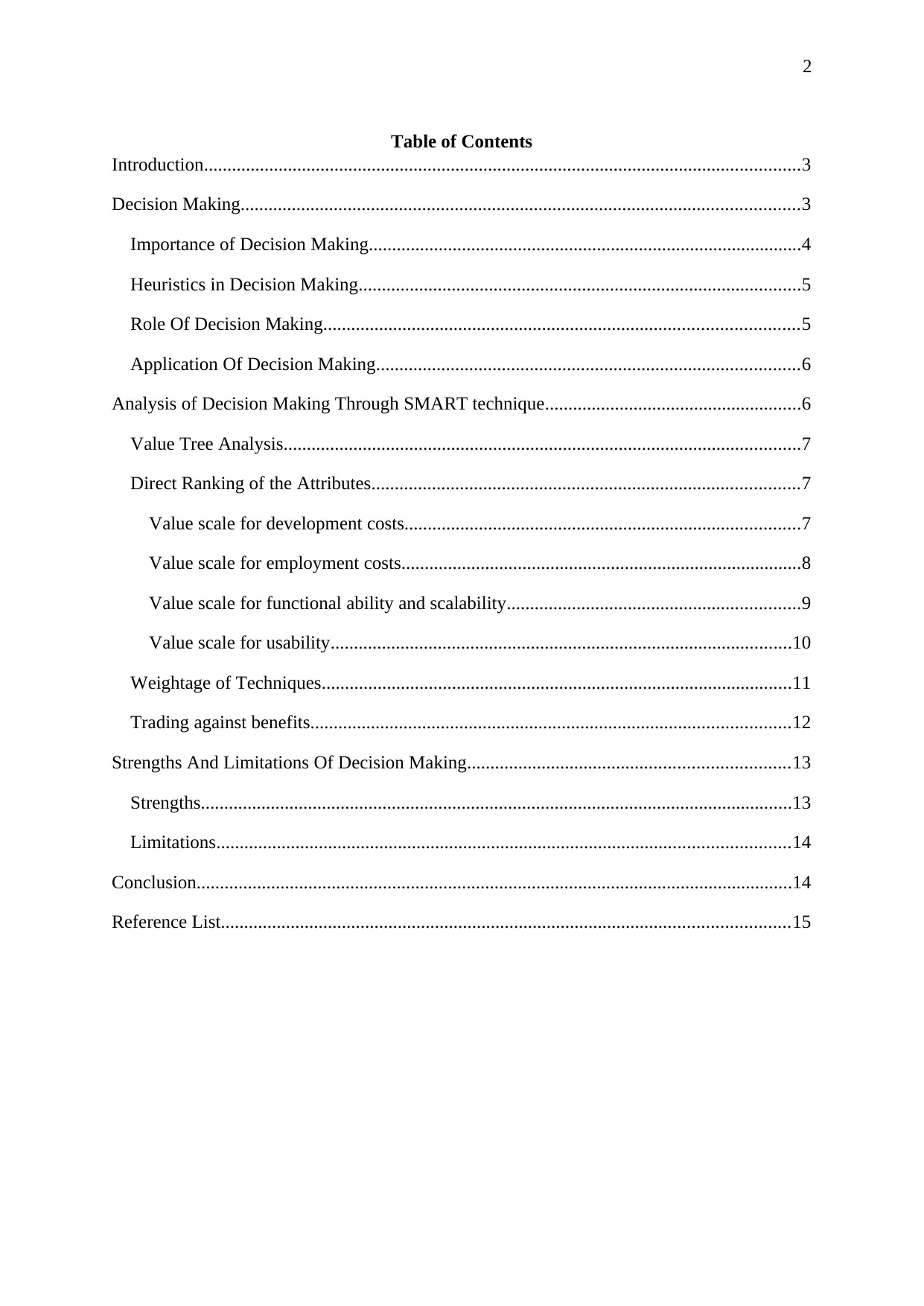
2
Table of Contents
Introduction................................................................................................................................3
Decision Making........................................................................................................................3
Importance of Decision Making.............................................................................................4
Heuristics in Decision Making...............................................................................................5
Role Of Decision Making......................................................................................................5
Application Of Decision Making...........................................................................................6
Analysis of Decision Making Through SMART technique.......................................................6
Value Tree Analysis...............................................................................................................7
Direct Ranking of the Attributes............................................................................................7
Value scale for development costs.....................................................................................7
Value scale for employment costs......................................................................................8
Value scale for functional ability and scalability...............................................................9
Value scale for usability...................................................................................................10
Weightage of Techniques.....................................................................................................11
Trading against benefits.......................................................................................................12
Strengths And Limitations Of Decision Making.....................................................................13
Strengths...............................................................................................................................13
Limitations...........................................................................................................................14
Conclusion................................................................................................................................14
Reference List..........................................................................................................................15
Table of Contents
Introduction................................................................................................................................3
Decision Making........................................................................................................................3
Importance of Decision Making.............................................................................................4
Heuristics in Decision Making...............................................................................................5
Role Of Decision Making......................................................................................................5
Application Of Decision Making...........................................................................................6
Analysis of Decision Making Through SMART technique.......................................................6
Value Tree Analysis...............................................................................................................7
Direct Ranking of the Attributes............................................................................................7
Value scale for development costs.....................................................................................7
Value scale for employment costs......................................................................................8
Value scale for functional ability and scalability...............................................................9
Value scale for usability...................................................................................................10
Weightage of Techniques.....................................................................................................11
Trading against benefits.......................................................................................................12
Strengths And Limitations Of Decision Making.....................................................................13
Strengths...............................................................................................................................13
Limitations...........................................................................................................................14
Conclusion................................................................................................................................14
Reference List..........................................................................................................................15
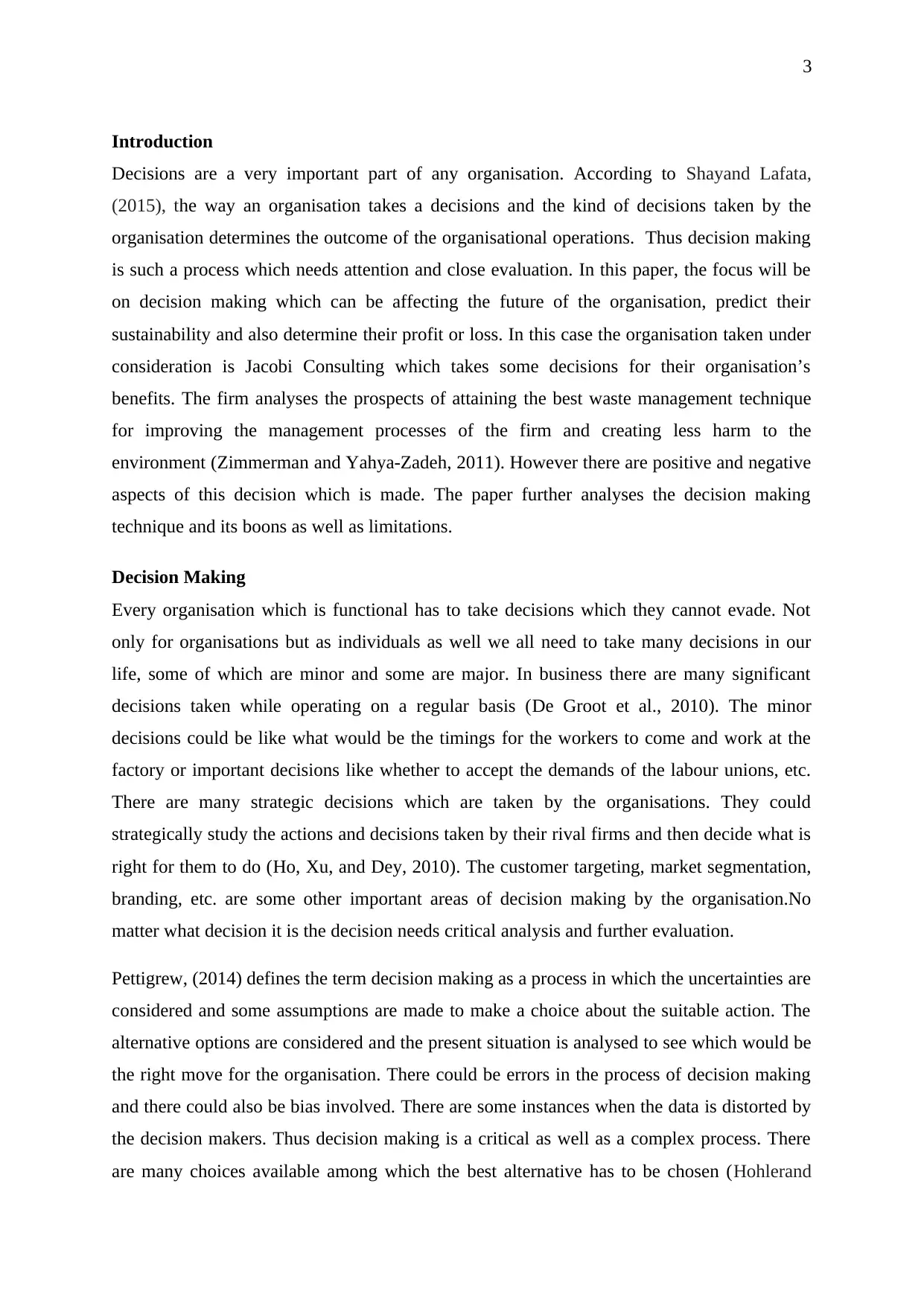
3
Introduction
Decisions are a very important part of any organisation. According to Shayand Lafata,
(2015), the way an organisation takes a decisions and the kind of decisions taken by the
organisation determines the outcome of the organisational operations. Thus decision making
is such a process which needs attention and close evaluation. In this paper, the focus will be
on decision making which can be affecting the future of the organisation, predict their
sustainability and also determine their profit or loss. In this case the organisation taken under
consideration is Jacobi Consulting which takes some decisions for their organisation’s
benefits. The firm analyses the prospects of attaining the best waste management technique
for improving the management processes of the firm and creating less harm to the
environment (Zimmerman and Yahya-Zadeh, 2011). However there are positive and negative
aspects of this decision which is made. The paper further analyses the decision making
technique and its boons as well as limitations.
Decision Making
Every organisation which is functional has to take decisions which they cannot evade. Not
only for organisations but as individuals as well we all need to take many decisions in our
life, some of which are minor and some are major. In business there are many significant
decisions taken while operating on a regular basis (De Groot et al., 2010). The minor
decisions could be like what would be the timings for the workers to come and work at the
factory or important decisions like whether to accept the demands of the labour unions, etc.
There are many strategic decisions which are taken by the organisations. They could
strategically study the actions and decisions taken by their rival firms and then decide what is
right for them to do (Ho, Xu, and Dey, 2010). The customer targeting, market segmentation,
branding, etc. are some other important areas of decision making by the organisation.No
matter what decision it is the decision needs critical analysis and further evaluation.
Pettigrew, (2014) defines the term decision making as a process in which the uncertainties are
considered and some assumptions are made to make a choice about the suitable action. The
alternative options are considered and the present situation is analysed to see which would be
the right move for the organisation. There could be errors in the process of decision making
and there could also be bias involved. There are some instances when the data is distorted by
the decision makers. Thus decision making is a critical as well as a complex process. There
are many choices available among which the best alternative has to be chosen (Hohlerand
Introduction
Decisions are a very important part of any organisation. According to Shayand Lafata,
(2015), the way an organisation takes a decisions and the kind of decisions taken by the
organisation determines the outcome of the organisational operations. Thus decision making
is such a process which needs attention and close evaluation. In this paper, the focus will be
on decision making which can be affecting the future of the organisation, predict their
sustainability and also determine their profit or loss. In this case the organisation taken under
consideration is Jacobi Consulting which takes some decisions for their organisation’s
benefits. The firm analyses the prospects of attaining the best waste management technique
for improving the management processes of the firm and creating less harm to the
environment (Zimmerman and Yahya-Zadeh, 2011). However there are positive and negative
aspects of this decision which is made. The paper further analyses the decision making
technique and its boons as well as limitations.
Decision Making
Every organisation which is functional has to take decisions which they cannot evade. Not
only for organisations but as individuals as well we all need to take many decisions in our
life, some of which are minor and some are major. In business there are many significant
decisions taken while operating on a regular basis (De Groot et al., 2010). The minor
decisions could be like what would be the timings for the workers to come and work at the
factory or important decisions like whether to accept the demands of the labour unions, etc.
There are many strategic decisions which are taken by the organisations. They could
strategically study the actions and decisions taken by their rival firms and then decide what is
right for them to do (Ho, Xu, and Dey, 2010). The customer targeting, market segmentation,
branding, etc. are some other important areas of decision making by the organisation.No
matter what decision it is the decision needs critical analysis and further evaluation.
Pettigrew, (2014) defines the term decision making as a process in which the uncertainties are
considered and some assumptions are made to make a choice about the suitable action. The
alternative options are considered and the present situation is analysed to see which would be
the right move for the organisation. There could be errors in the process of decision making
and there could also be bias involved. There are some instances when the data is distorted by
the decision makers. Thus decision making is a critical as well as a complex process. There
are many choices available among which the best alternative has to be chosen (Hohlerand
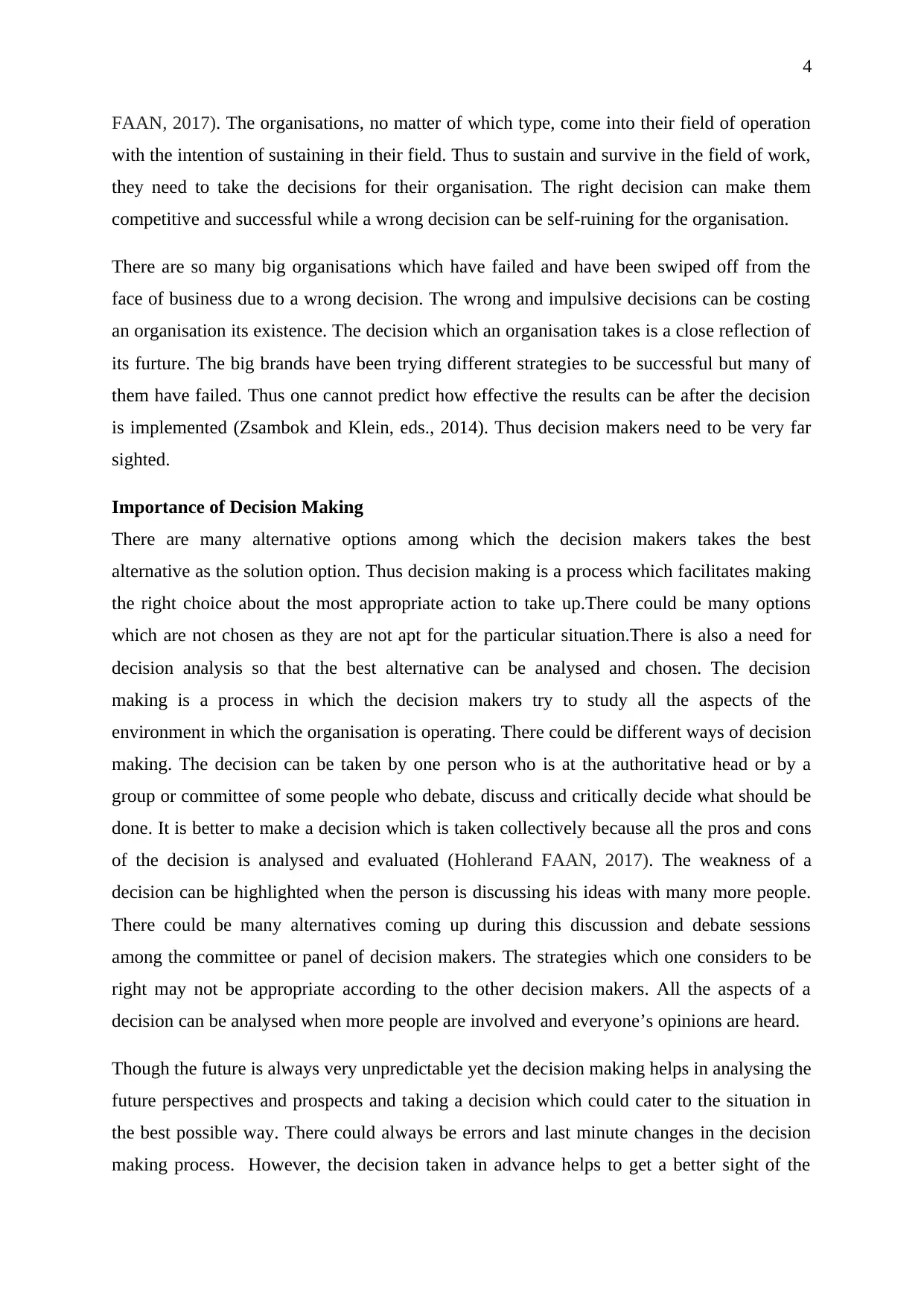
4
FAAN, 2017). The organisations, no matter of which type, come into their field of operation
with the intention of sustaining in their field. Thus to sustain and survive in the field of work,
they need to take the decisions for their organisation. The right decision can make them
competitive and successful while a wrong decision can be self-ruining for the organisation.
There are so many big organisations which have failed and have been swiped off from the
face of business due to a wrong decision. The wrong and impulsive decisions can be costing
an organisation its existence. The decision which an organisation takes is a close reflection of
its furture. The big brands have been trying different strategies to be successful but many of
them have failed. Thus one cannot predict how effective the results can be after the decision
is implemented (Zsambok and Klein, eds., 2014). Thus decision makers need to be very far
sighted.
Importance of Decision Making
There are many alternative options among which the decision makers takes the best
alternative as the solution option. Thus decision making is a process which facilitates making
the right choice about the most appropriate action to take up.There could be many options
which are not chosen as they are not apt for the particular situation.There is also a need for
decision analysis so that the best alternative can be analysed and chosen. The decision
making is a process in which the decision makers try to study all the aspects of the
environment in which the organisation is operating. There could be different ways of decision
making. The decision can be taken by one person who is at the authoritative head or by a
group or committee of some people who debate, discuss and critically decide what should be
done. It is better to make a decision which is taken collectively because all the pros and cons
of the decision is analysed and evaluated (Hohlerand FAAN, 2017). The weakness of a
decision can be highlighted when the person is discussing his ideas with many more people.
There could be many alternatives coming up during this discussion and debate sessions
among the committee or panel of decision makers. The strategies which one considers to be
right may not be appropriate according to the other decision makers. All the aspects of a
decision can be analysed when more people are involved and everyone’s opinions are heard.
Though the future is always very unpredictable yet the decision making helps in analysing the
future perspectives and prospects and taking a decision which could cater to the situation in
the best possible way. There could always be errors and last minute changes in the decision
making process. However, the decision taken in advance helps to get a better sight of the
FAAN, 2017). The organisations, no matter of which type, come into their field of operation
with the intention of sustaining in their field. Thus to sustain and survive in the field of work,
they need to take the decisions for their organisation. The right decision can make them
competitive and successful while a wrong decision can be self-ruining for the organisation.
There are so many big organisations which have failed and have been swiped off from the
face of business due to a wrong decision. The wrong and impulsive decisions can be costing
an organisation its existence. The decision which an organisation takes is a close reflection of
its furture. The big brands have been trying different strategies to be successful but many of
them have failed. Thus one cannot predict how effective the results can be after the decision
is implemented (Zsambok and Klein, eds., 2014). Thus decision makers need to be very far
sighted.
Importance of Decision Making
There are many alternative options among which the decision makers takes the best
alternative as the solution option. Thus decision making is a process which facilitates making
the right choice about the most appropriate action to take up.There could be many options
which are not chosen as they are not apt for the particular situation.There is also a need for
decision analysis so that the best alternative can be analysed and chosen. The decision
making is a process in which the decision makers try to study all the aspects of the
environment in which the organisation is operating. There could be different ways of decision
making. The decision can be taken by one person who is at the authoritative head or by a
group or committee of some people who debate, discuss and critically decide what should be
done. It is better to make a decision which is taken collectively because all the pros and cons
of the decision is analysed and evaluated (Hohlerand FAAN, 2017). The weakness of a
decision can be highlighted when the person is discussing his ideas with many more people.
There could be many alternatives coming up during this discussion and debate sessions
among the committee or panel of decision makers. The strategies which one considers to be
right may not be appropriate according to the other decision makers. All the aspects of a
decision can be analysed when more people are involved and everyone’s opinions are heard.
Though the future is always very unpredictable yet the decision making helps in analysing the
future perspectives and prospects and taking a decision which could cater to the situation in
the best possible way. There could always be errors and last minute changes in the decision
making process. However, the decision taken in advance helps to get a better sight of the
Secure Best Marks with AI Grader
Need help grading? Try our AI Grader for instant feedback on your assignments.
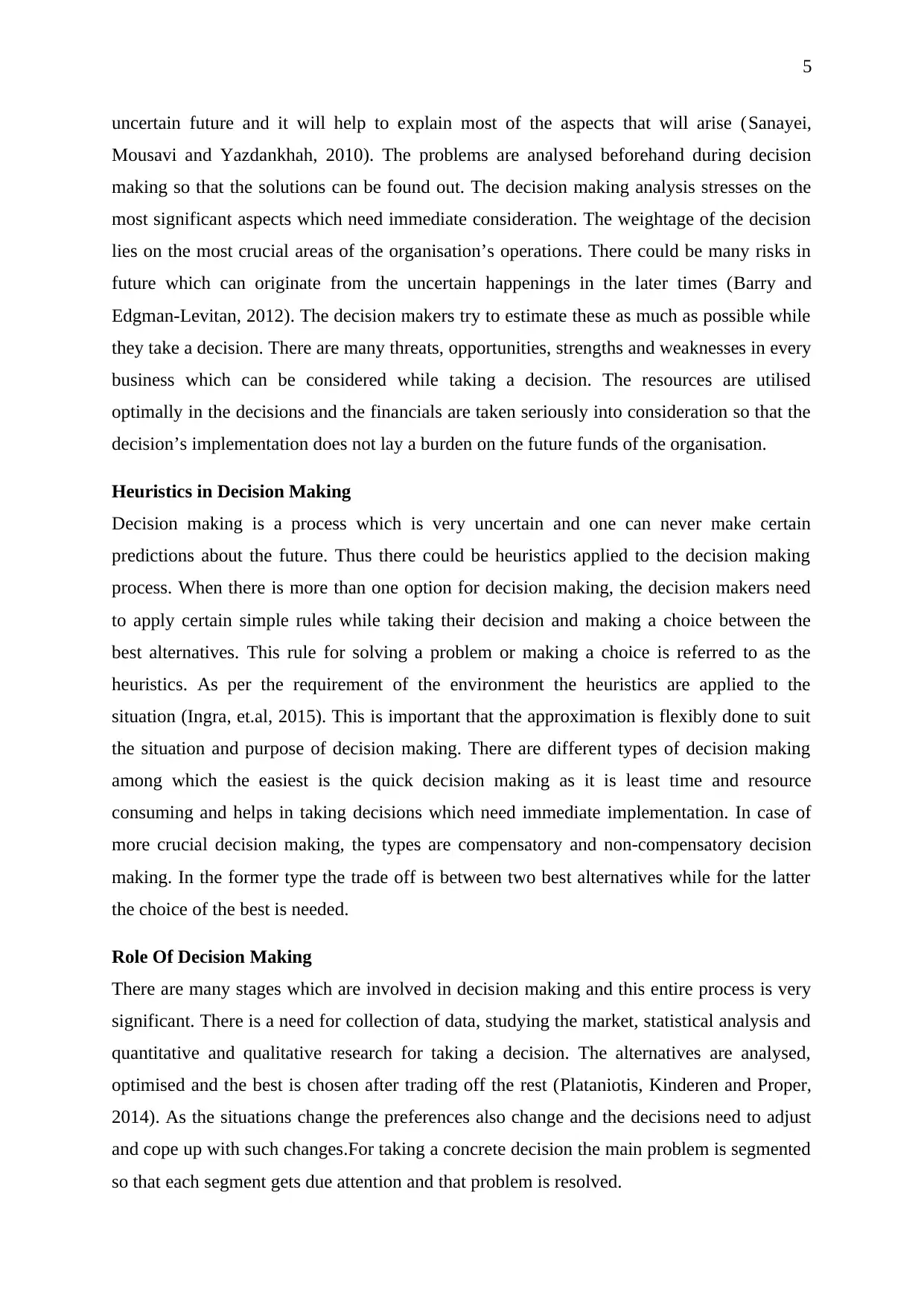
5
uncertain future and it will help to explain most of the aspects that will arise (Sanayei,
Mousavi and Yazdankhah, 2010). The problems are analysed beforehand during decision
making so that the solutions can be found out. The decision making analysis stresses on the
most significant aspects which need immediate consideration. The weightage of the decision
lies on the most crucial areas of the organisation’s operations. There could be many risks in
future which can originate from the uncertain happenings in the later times (Barry and
Edgman-Levitan, 2012). The decision makers try to estimate these as much as possible while
they take a decision. There are many threats, opportunities, strengths and weaknesses in every
business which can be considered while taking a decision. The resources are utilised
optimally in the decisions and the financials are taken seriously into consideration so that the
decision’s implementation does not lay a burden on the future funds of the organisation.
Heuristics in Decision Making
Decision making is a process which is very uncertain and one can never make certain
predictions about the future. Thus there could be heuristics applied to the decision making
process. When there is more than one option for decision making, the decision makers need
to apply certain simple rules while taking their decision and making a choice between the
best alternatives. This rule for solving a problem or making a choice is referred to as the
heuristics. As per the requirement of the environment the heuristics are applied to the
situation (Ingra, et.al, 2015). This is important that the approximation is flexibly done to suit
the situation and purpose of decision making. There are different types of decision making
among which the easiest is the quick decision making as it is least time and resource
consuming and helps in taking decisions which need immediate implementation. In case of
more crucial decision making, the types are compensatory and non-compensatory decision
making. In the former type the trade off is between two best alternatives while for the latter
the choice of the best is needed.
Role Of Decision Making
There are many stages which are involved in decision making and this entire process is very
significant. There is a need for collection of data, studying the market, statistical analysis and
quantitative and qualitative research for taking a decision. The alternatives are analysed,
optimised and the best is chosen after trading off the rest (Plataniotis, Kinderen and Proper,
2014). As the situations change the preferences also change and the decisions need to adjust
and cope up with such changes.For taking a concrete decision the main problem is segmented
so that each segment gets due attention and that problem is resolved.
uncertain future and it will help to explain most of the aspects that will arise (Sanayei,
Mousavi and Yazdankhah, 2010). The problems are analysed beforehand during decision
making so that the solutions can be found out. The decision making analysis stresses on the
most significant aspects which need immediate consideration. The weightage of the decision
lies on the most crucial areas of the organisation’s operations. There could be many risks in
future which can originate from the uncertain happenings in the later times (Barry and
Edgman-Levitan, 2012). The decision makers try to estimate these as much as possible while
they take a decision. There are many threats, opportunities, strengths and weaknesses in every
business which can be considered while taking a decision. The resources are utilised
optimally in the decisions and the financials are taken seriously into consideration so that the
decision’s implementation does not lay a burden on the future funds of the organisation.
Heuristics in Decision Making
Decision making is a process which is very uncertain and one can never make certain
predictions about the future. Thus there could be heuristics applied to the decision making
process. When there is more than one option for decision making, the decision makers need
to apply certain simple rules while taking their decision and making a choice between the
best alternatives. This rule for solving a problem or making a choice is referred to as the
heuristics. As per the requirement of the environment the heuristics are applied to the
situation (Ingra, et.al, 2015). This is important that the approximation is flexibly done to suit
the situation and purpose of decision making. There are different types of decision making
among which the easiest is the quick decision making as it is least time and resource
consuming and helps in taking decisions which need immediate implementation. In case of
more crucial decision making, the types are compensatory and non-compensatory decision
making. In the former type the trade off is between two best alternatives while for the latter
the choice of the best is needed.
Role Of Decision Making
There are many stages which are involved in decision making and this entire process is very
significant. There is a need for collection of data, studying the market, statistical analysis and
quantitative and qualitative research for taking a decision. The alternatives are analysed,
optimised and the best is chosen after trading off the rest (Plataniotis, Kinderen and Proper,
2014). As the situations change the preferences also change and the decisions need to adjust
and cope up with such changes.For taking a concrete decision the main problem is segmented
so that each segment gets due attention and that problem is resolved.
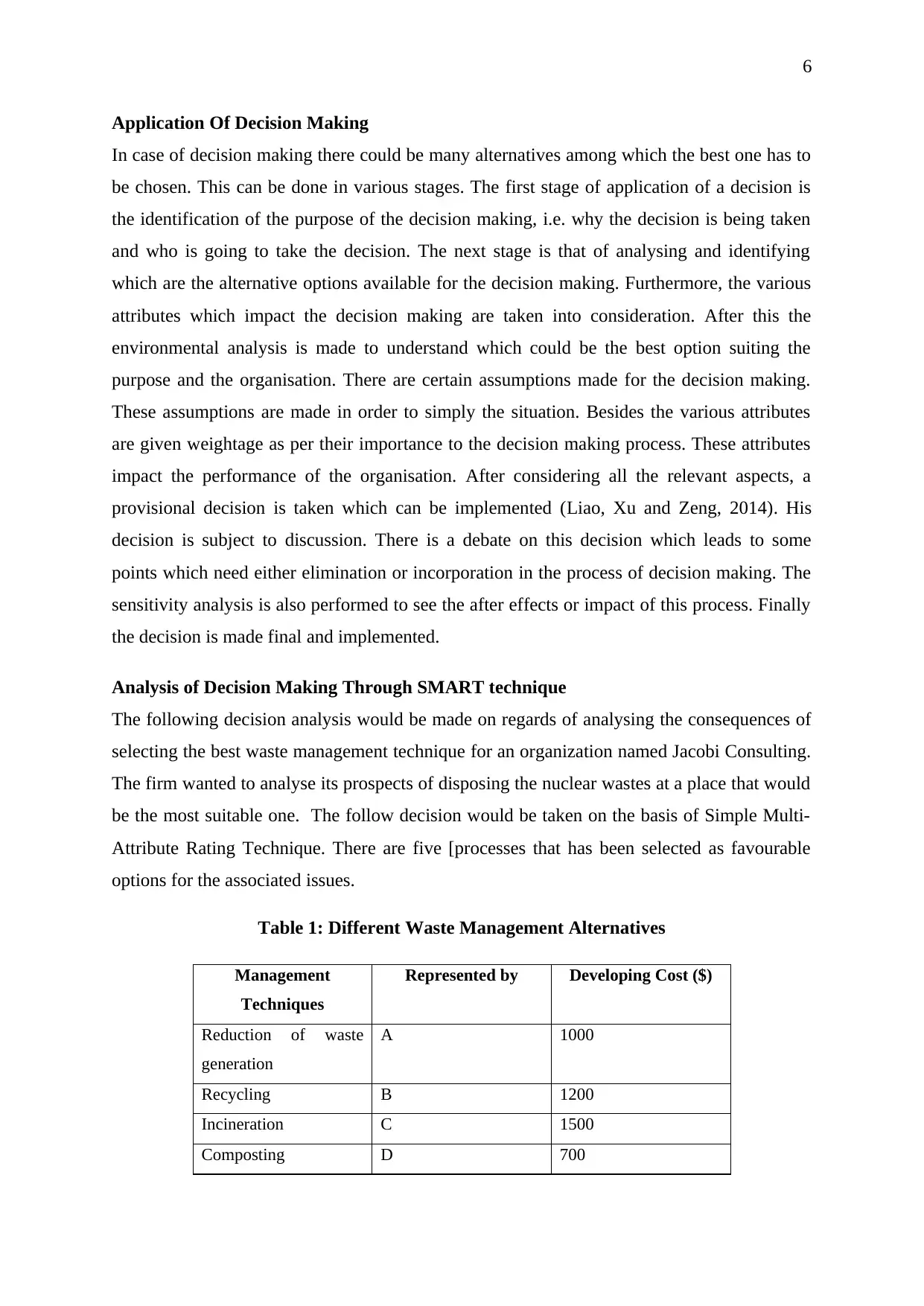
6
Application Of Decision Making
In case of decision making there could be many alternatives among which the best one has to
be chosen. This can be done in various stages. The first stage of application of a decision is
the identification of the purpose of the decision making, i.e. why the decision is being taken
and who is going to take the decision. The next stage is that of analysing and identifying
which are the alternative options available for the decision making. Furthermore, the various
attributes which impact the decision making are taken into consideration. After this the
environmental analysis is made to understand which could be the best option suiting the
purpose and the organisation. There are certain assumptions made for the decision making.
These assumptions are made in order to simply the situation. Besides the various attributes
are given weightage as per their importance to the decision making process. These attributes
impact the performance of the organisation. After considering all the relevant aspects, a
provisional decision is taken which can be implemented (Liao, Xu and Zeng, 2014). His
decision is subject to discussion. There is a debate on this decision which leads to some
points which need either elimination or incorporation in the process of decision making. The
sensitivity analysis is also performed to see the after effects or impact of this process. Finally
the decision is made final and implemented.
Analysis of Decision Making Through SMART technique
The following decision analysis would be made on regards of analysing the consequences of
selecting the best waste management technique for an organization named Jacobi Consulting.
The firm wanted to analyse its prospects of disposing the nuclear wastes at a place that would
be the most suitable one. The follow decision would be taken on the basis of Simple Multi-
Attribute Rating Technique. There are five [processes that has been selected as favourable
options for the associated issues.
Table 1: Different Waste Management Alternatives
Management
Techniques
Represented by Developing Cost ($)
Reduction of waste
generation
A 1000
Recycling B 1200
Incineration C 1500
Composting D 700
Application Of Decision Making
In case of decision making there could be many alternatives among which the best one has to
be chosen. This can be done in various stages. The first stage of application of a decision is
the identification of the purpose of the decision making, i.e. why the decision is being taken
and who is going to take the decision. The next stage is that of analysing and identifying
which are the alternative options available for the decision making. Furthermore, the various
attributes which impact the decision making are taken into consideration. After this the
environmental analysis is made to understand which could be the best option suiting the
purpose and the organisation. There are certain assumptions made for the decision making.
These assumptions are made in order to simply the situation. Besides the various attributes
are given weightage as per their importance to the decision making process. These attributes
impact the performance of the organisation. After considering all the relevant aspects, a
provisional decision is taken which can be implemented (Liao, Xu and Zeng, 2014). His
decision is subject to discussion. There is a debate on this decision which leads to some
points which need either elimination or incorporation in the process of decision making. The
sensitivity analysis is also performed to see the after effects or impact of this process. Finally
the decision is made final and implemented.
Analysis of Decision Making Through SMART technique
The following decision analysis would be made on regards of analysing the consequences of
selecting the best waste management technique for an organization named Jacobi Consulting.
The firm wanted to analyse its prospects of disposing the nuclear wastes at a place that would
be the most suitable one. The follow decision would be taken on the basis of Simple Multi-
Attribute Rating Technique. There are five [processes that has been selected as favourable
options for the associated issues.
Table 1: Different Waste Management Alternatives
Management
Techniques
Represented by Developing Cost ($)
Reduction of waste
generation
A 1000
Recycling B 1200
Incineration C 1500
Composting D 700
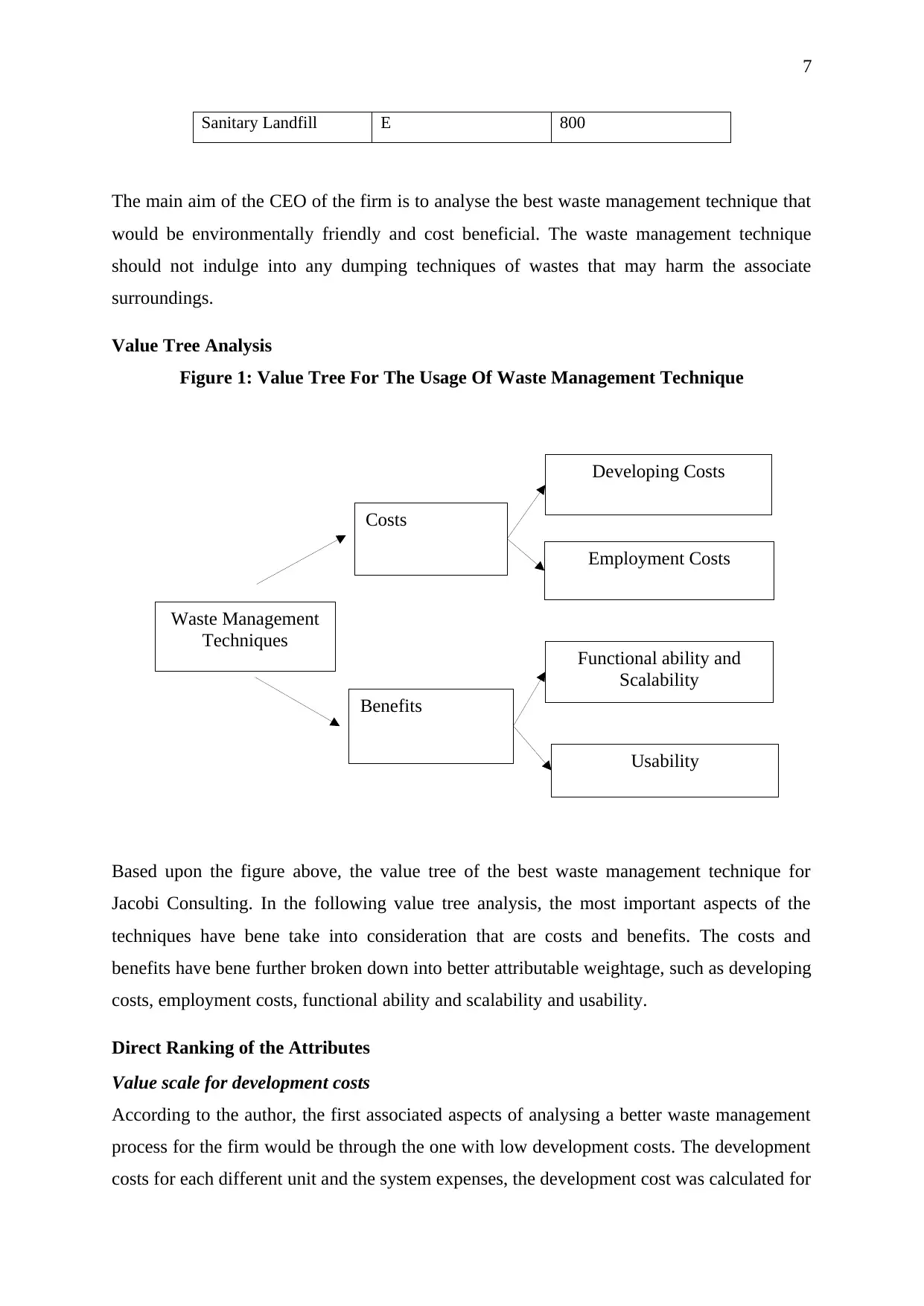
Waste Management
Techniques
Costs
Benefits
Developing Costs
Employment Costs
Functional ability and
Scalability
Usability
7
Sanitary Landfill E 800
The main aim of the CEO of the firm is to analyse the best waste management technique that
would be environmentally friendly and cost beneficial. The waste management technique
should not indulge into any dumping techniques of wastes that may harm the associate
surroundings.
Value Tree Analysis
Figure 1: Value Tree For The Usage Of Waste Management Technique
Based upon the figure above, the value tree of the best waste management technique for
Jacobi Consulting. In the following value tree analysis, the most important aspects of the
techniques have bene take into consideration that are costs and benefits. The costs and
benefits have bene further broken down into better attributable weightage, such as developing
costs, employment costs, functional ability and scalability and usability.
Direct Ranking of the Attributes
Value scale for development costs
According to the author, the first associated aspects of analysing a better waste management
process for the firm would be through the one with low development costs. The development
costs for each different unit and the system expenses, the development cost was calculated for
Techniques
Costs
Benefits
Developing Costs
Employment Costs
Functional ability and
Scalability
Usability
7
Sanitary Landfill E 800
The main aim of the CEO of the firm is to analyse the best waste management technique that
would be environmentally friendly and cost beneficial. The waste management technique
should not indulge into any dumping techniques of wastes that may harm the associate
surroundings.
Value Tree Analysis
Figure 1: Value Tree For The Usage Of Waste Management Technique
Based upon the figure above, the value tree of the best waste management technique for
Jacobi Consulting. In the following value tree analysis, the most important aspects of the
techniques have bene take into consideration that are costs and benefits. The costs and
benefits have bene further broken down into better attributable weightage, such as developing
costs, employment costs, functional ability and scalability and usability.
Direct Ranking of the Attributes
Value scale for development costs
According to the author, the first associated aspects of analysing a better waste management
process for the firm would be through the one with low development costs. The development
costs for each different unit and the system expenses, the development cost was calculated for
Paraphrase This Document
Need a fresh take? Get an instant paraphrase of this document with our AI Paraphraser
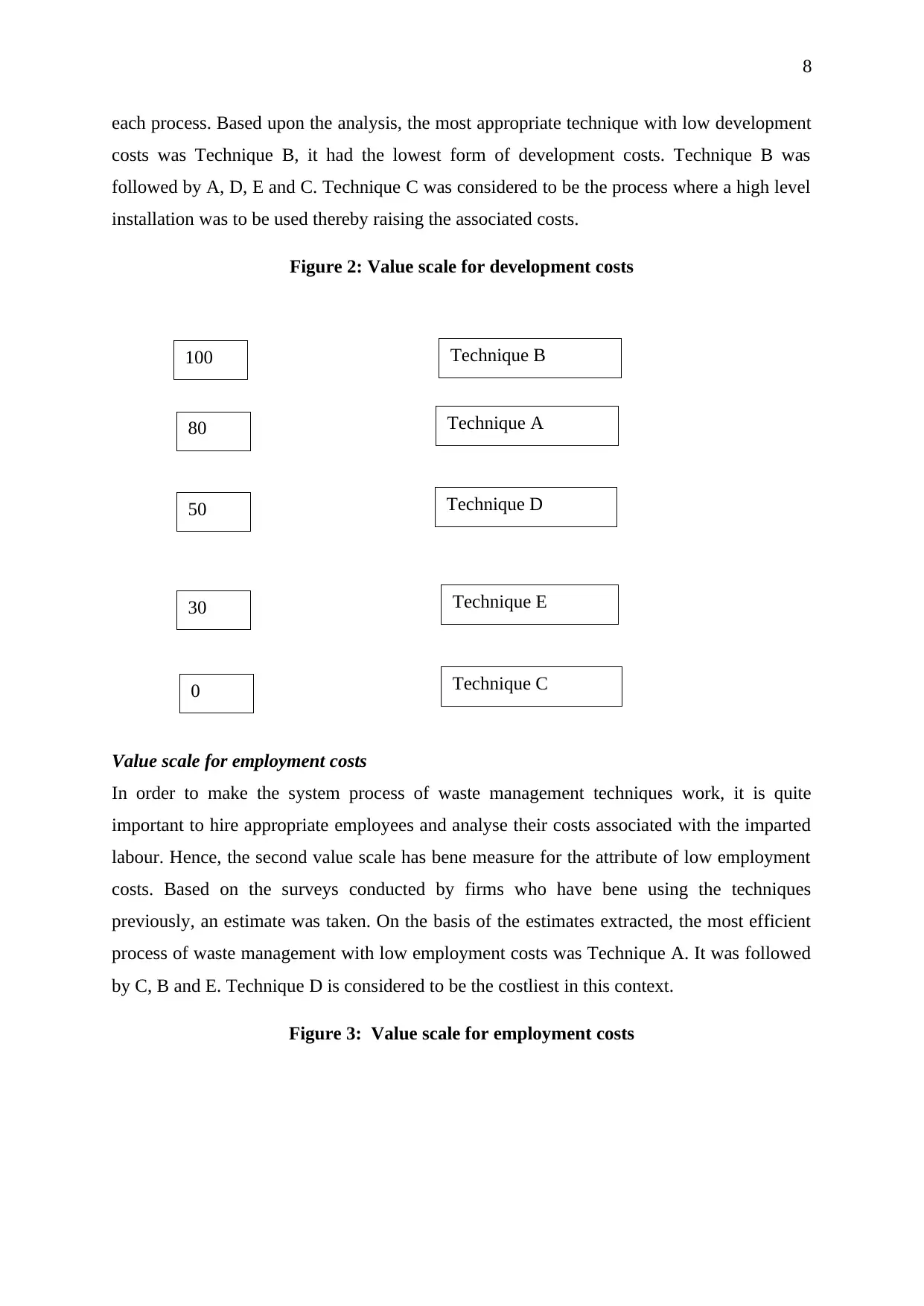
Technique B
Technique A
Technique D
Technique E
Technique C
100
80
50
30
0
8
each process. Based upon the analysis, the most appropriate technique with low development
costs was Technique B, it had the lowest form of development costs. Technique B was
followed by A, D, E and C. Technique C was considered to be the process where a high level
installation was to be used thereby raising the associated costs.
Figure 2: Value scale for development costs
Value scale for employment costs
In order to make the system process of waste management techniques work, it is quite
important to hire appropriate employees and analyse their costs associated with the imparted
labour. Hence, the second value scale has bene measure for the attribute of low employment
costs. Based on the surveys conducted by firms who have bene using the techniques
previously, an estimate was taken. On the basis of the estimates extracted, the most efficient
process of waste management with low employment costs was Technique A. It was followed
by C, B and E. Technique D is considered to be the costliest in this context.
Figure 3: Value scale for employment costs
Technique A
Technique D
Technique E
Technique C
100
80
50
30
0
8
each process. Based upon the analysis, the most appropriate technique with low development
costs was Technique B, it had the lowest form of development costs. Technique B was
followed by A, D, E and C. Technique C was considered to be the process where a high level
installation was to be used thereby raising the associated costs.
Figure 2: Value scale for development costs
Value scale for employment costs
In order to make the system process of waste management techniques work, it is quite
important to hire appropriate employees and analyse their costs associated with the imparted
labour. Hence, the second value scale has bene measure for the attribute of low employment
costs. Based on the surveys conducted by firms who have bene using the techniques
previously, an estimate was taken. On the basis of the estimates extracted, the most efficient
process of waste management with low employment costs was Technique A. It was followed
by C, B and E. Technique D is considered to be the costliest in this context.
Figure 3: Value scale for employment costs
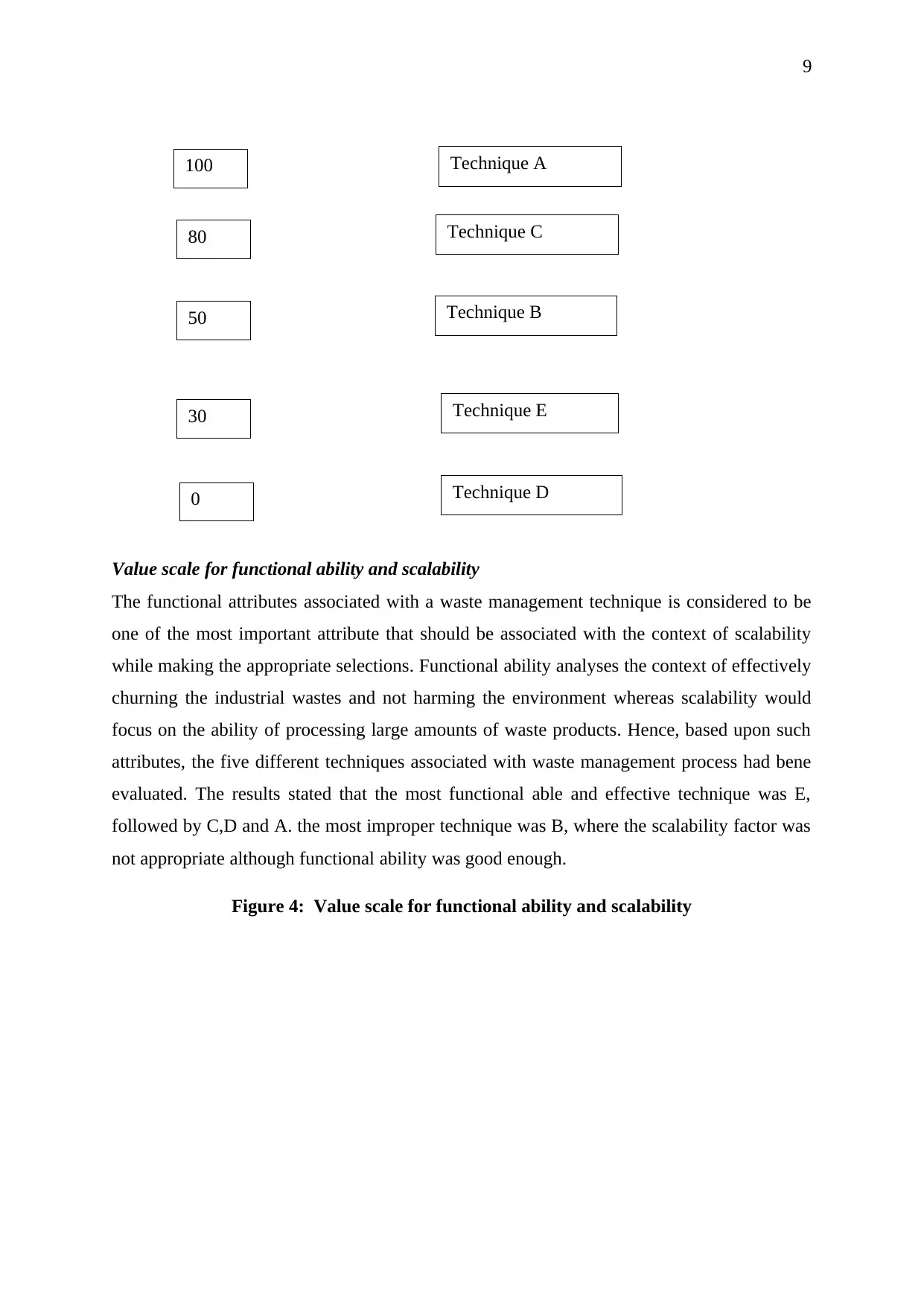
Technique A
Technique C
Technique B
Technique E
Technique D
100
80
50
30
0
9
Value scale for functional ability and scalability
The functional attributes associated with a waste management technique is considered to be
one of the most important attribute that should be associated with the context of scalability
while making the appropriate selections. Functional ability analyses the context of effectively
churning the industrial wastes and not harming the environment whereas scalability would
focus on the ability of processing large amounts of waste products. Hence, based upon such
attributes, the five different techniques associated with waste management process had bene
evaluated. The results stated that the most functional able and effective technique was E,
followed by C,D and A. the most improper technique was B, where the scalability factor was
not appropriate although functional ability was good enough.
Figure 4: Value scale for functional ability and scalability
Technique C
Technique B
Technique E
Technique D
100
80
50
30
0
9
Value scale for functional ability and scalability
The functional attributes associated with a waste management technique is considered to be
one of the most important attribute that should be associated with the context of scalability
while making the appropriate selections. Functional ability analyses the context of effectively
churning the industrial wastes and not harming the environment whereas scalability would
focus on the ability of processing large amounts of waste products. Hence, based upon such
attributes, the five different techniques associated with waste management process had bene
evaluated. The results stated that the most functional able and effective technique was E,
followed by C,D and A. the most improper technique was B, where the scalability factor was
not appropriate although functional ability was good enough.
Figure 4: Value scale for functional ability and scalability
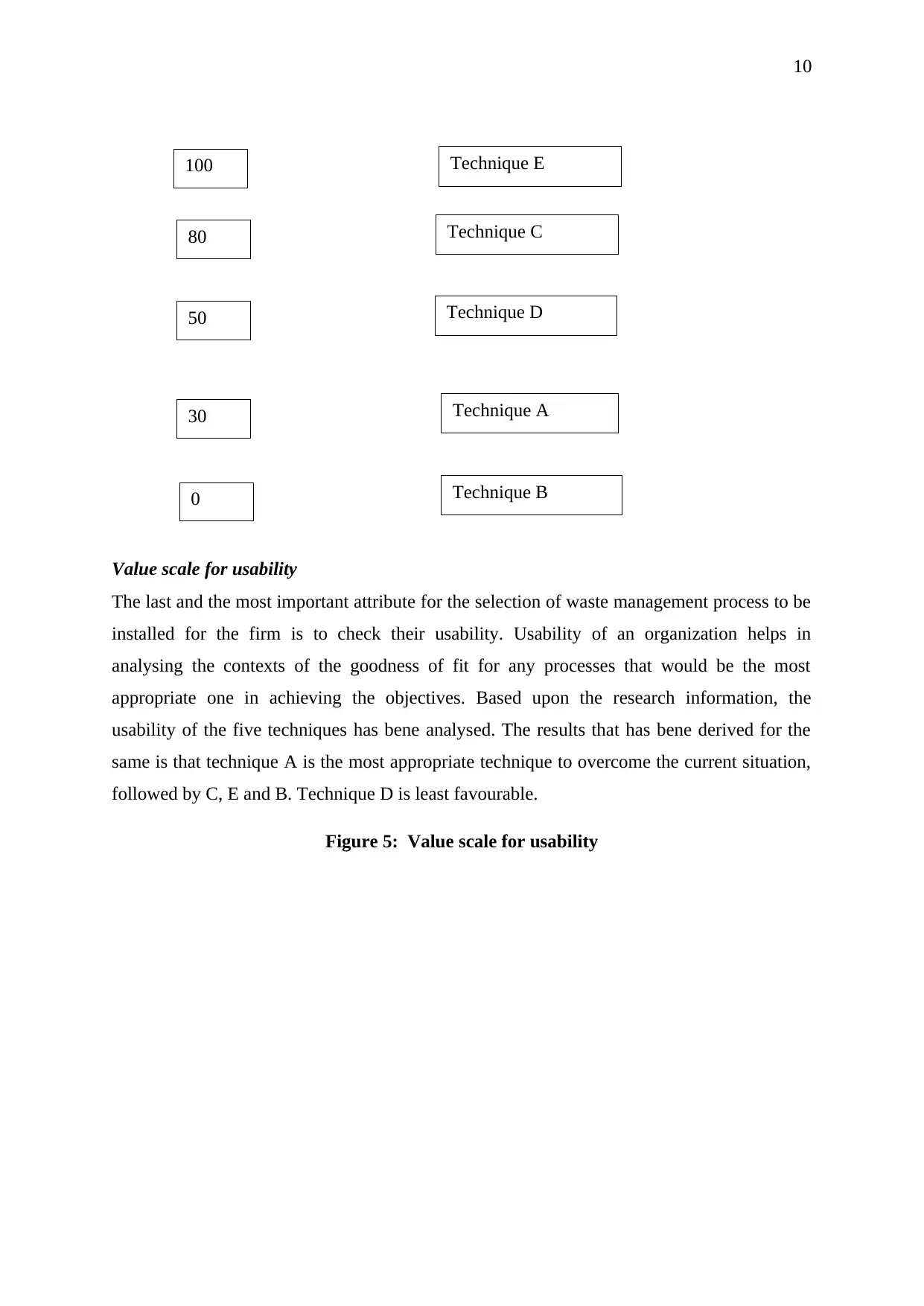
Technique E
Technique C
Technique D
Technique A
Technique B
100
80
50
30
0
10
Value scale for usability
The last and the most important attribute for the selection of waste management process to be
installed for the firm is to check their usability. Usability of an organization helps in
analysing the contexts of the goodness of fit for any processes that would be the most
appropriate one in achieving the objectives. Based upon the research information, the
usability of the five techniques has bene analysed. The results that has bene derived for the
same is that technique A is the most appropriate technique to overcome the current situation,
followed by C, E and B. Technique D is least favourable.
Figure 5: Value scale for usability
Technique C
Technique D
Technique A
Technique B
100
80
50
30
0
10
Value scale for usability
The last and the most important attribute for the selection of waste management process to be
installed for the firm is to check their usability. Usability of an organization helps in
analysing the contexts of the goodness of fit for any processes that would be the most
appropriate one in achieving the objectives. Based upon the research information, the
usability of the five techniques has bene analysed. The results that has bene derived for the
same is that technique A is the most appropriate technique to overcome the current situation,
followed by C, E and B. Technique D is least favourable.
Figure 5: Value scale for usability
Secure Best Marks with AI Grader
Need help grading? Try our AI Grader for instant feedback on your assignments.
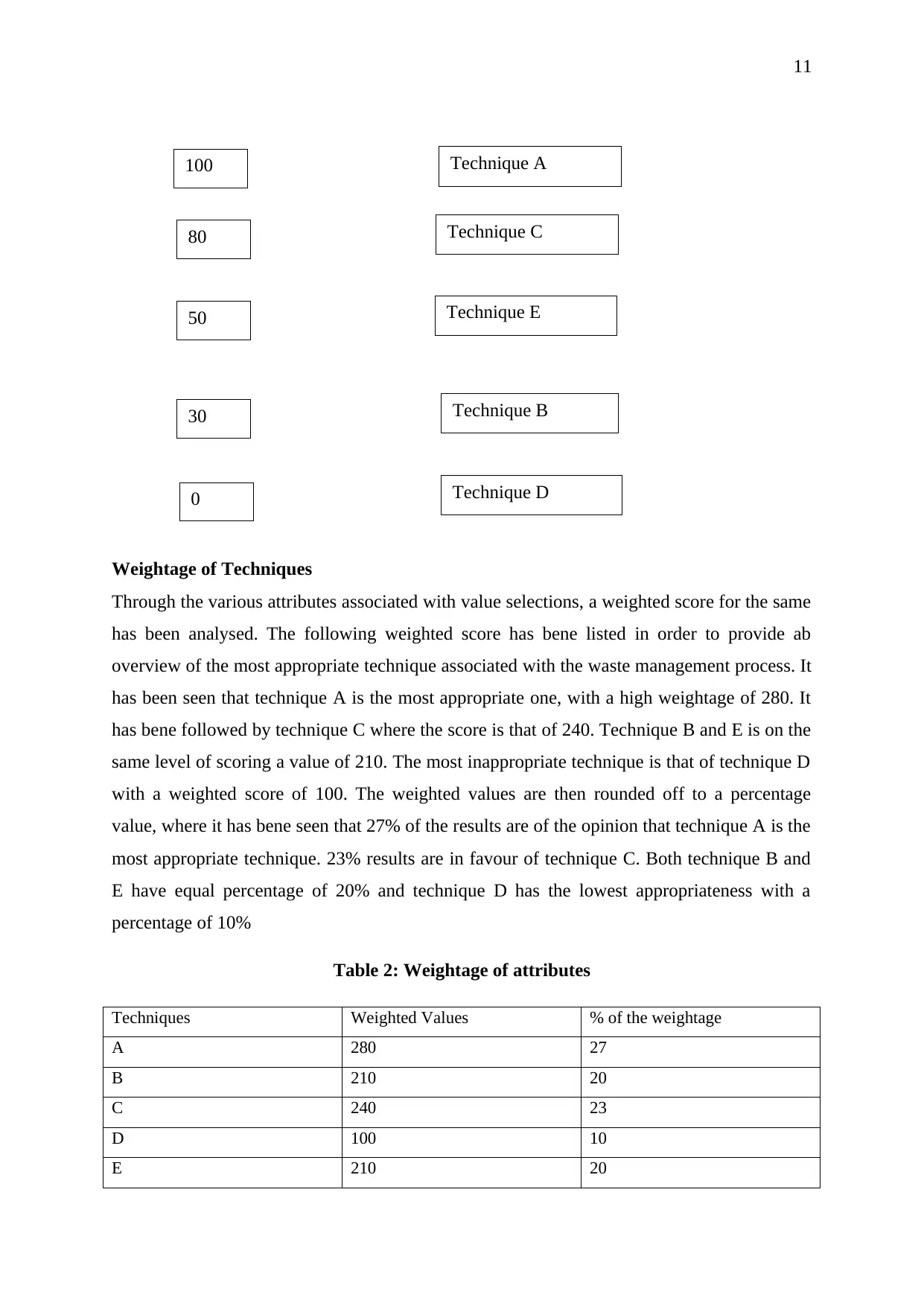
Technique A
Technique C
Technique E
Technique B
Technique D
100
80
50
30
0
11
Weightage of Techniques
Through the various attributes associated with value selections, a weighted score for the same
has been analysed. The following weighted score has bene listed in order to provide ab
overview of the most appropriate technique associated with the waste management process. It
has been seen that technique A is the most appropriate one, with a high weightage of 280. It
has bene followed by technique C where the score is that of 240. Technique B and E is on the
same level of scoring a value of 210. The most inappropriate technique is that of technique D
with a weighted score of 100. The weighted values are then rounded off to a percentage
value, where it has bene seen that 27% of the results are of the opinion that technique A is the
most appropriate technique. 23% results are in favour of technique C. Both technique B and
E have equal percentage of 20% and technique D has the lowest appropriateness with a
percentage of 10%
Table 2: Weightage of attributes
Techniques Weighted Values % of the weightage
A 280 27
B 210 20
C 240 23
D 100 10
E 210 20
Technique C
Technique E
Technique B
Technique D
100
80
50
30
0
11
Weightage of Techniques
Through the various attributes associated with value selections, a weighted score for the same
has been analysed. The following weighted score has bene listed in order to provide ab
overview of the most appropriate technique associated with the waste management process. It
has been seen that technique A is the most appropriate one, with a high weightage of 280. It
has bene followed by technique C where the score is that of 240. Technique B and E is on the
same level of scoring a value of 210. The most inappropriate technique is that of technique D
with a weighted score of 100. The weighted values are then rounded off to a percentage
value, where it has bene seen that 27% of the results are of the opinion that technique A is the
most appropriate technique. 23% results are in favour of technique C. Both technique B and
E have equal percentage of 20% and technique D has the lowest appropriateness with a
percentage of 10%
Table 2: Weightage of attributes
Techniques Weighted Values % of the weightage
A 280 27
B 210 20
C 240 23
D 100 10
E 210 20
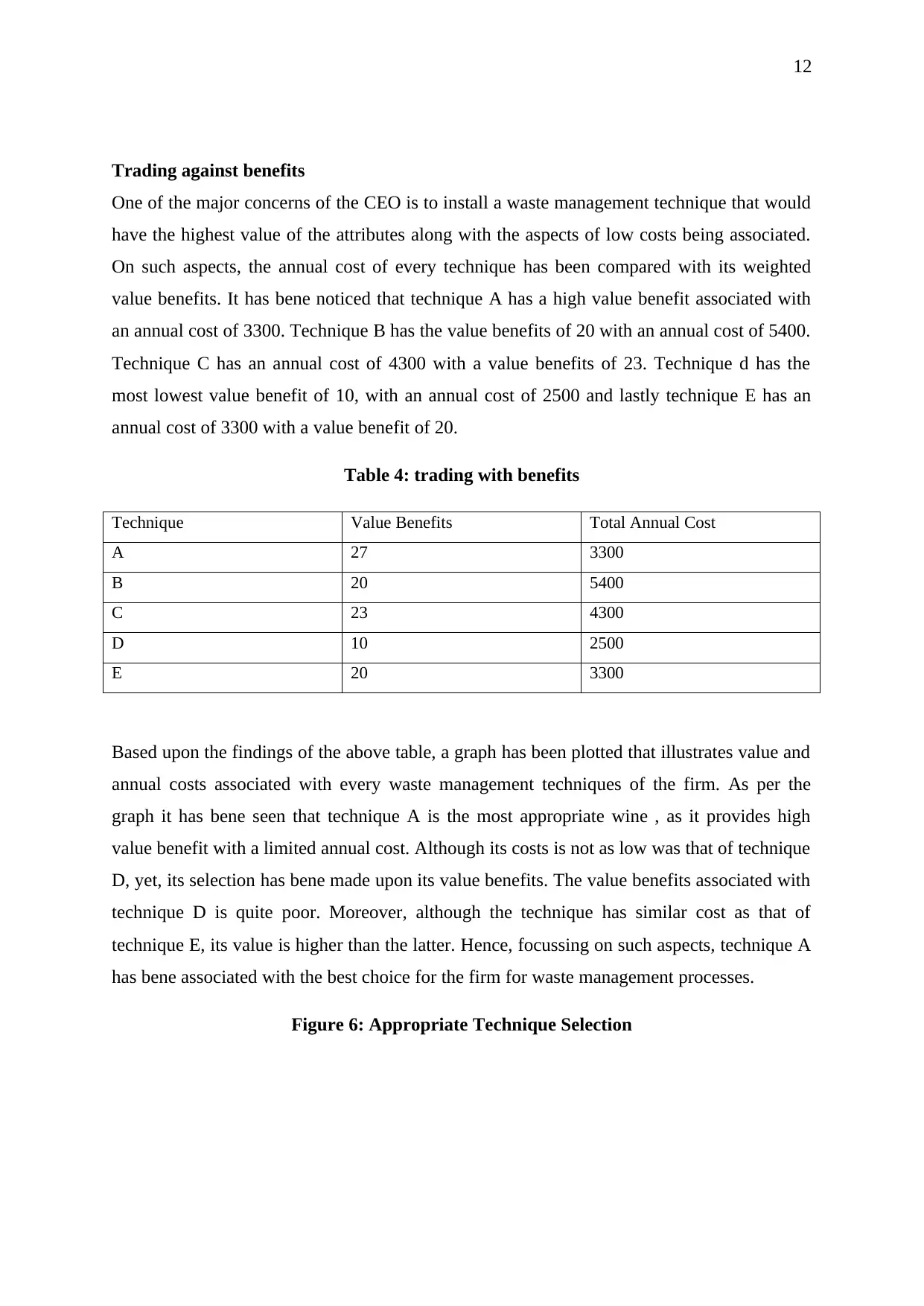
12
Trading against benefits
One of the major concerns of the CEO is to install a waste management technique that would
have the highest value of the attributes along with the aspects of low costs being associated.
On such aspects, the annual cost of every technique has been compared with its weighted
value benefits. It has bene noticed that technique A has a high value benefit associated with
an annual cost of 3300. Technique B has the value benefits of 20 with an annual cost of 5400.
Technique C has an annual cost of 4300 with a value benefits of 23. Technique d has the
most lowest value benefit of 10, with an annual cost of 2500 and lastly technique E has an
annual cost of 3300 with a value benefit of 20.
Table 4: trading with benefits
Technique Value Benefits Total Annual Cost
A 27 3300
B 20 5400
C 23 4300
D 10 2500
E 20 3300
Based upon the findings of the above table, a graph has been plotted that illustrates value and
annual costs associated with every waste management techniques of the firm. As per the
graph it has bene seen that technique A is the most appropriate wine , as it provides high
value benefit with a limited annual cost. Although its costs is not as low was that of technique
D, yet, its selection has bene made upon its value benefits. The value benefits associated with
technique D is quite poor. Moreover, although the technique has similar cost as that of
technique E, its value is higher than the latter. Hence, focussing on such aspects, technique A
has bene associated with the best choice for the firm for waste management processes.
Figure 6: Appropriate Technique Selection
Trading against benefits
One of the major concerns of the CEO is to install a waste management technique that would
have the highest value of the attributes along with the aspects of low costs being associated.
On such aspects, the annual cost of every technique has been compared with its weighted
value benefits. It has bene noticed that technique A has a high value benefit associated with
an annual cost of 3300. Technique B has the value benefits of 20 with an annual cost of 5400.
Technique C has an annual cost of 4300 with a value benefits of 23. Technique d has the
most lowest value benefit of 10, with an annual cost of 2500 and lastly technique E has an
annual cost of 3300 with a value benefit of 20.
Table 4: trading with benefits
Technique Value Benefits Total Annual Cost
A 27 3300
B 20 5400
C 23 4300
D 10 2500
E 20 3300
Based upon the findings of the above table, a graph has been plotted that illustrates value and
annual costs associated with every waste management techniques of the firm. As per the
graph it has bene seen that technique A is the most appropriate wine , as it provides high
value benefit with a limited annual cost. Although its costs is not as low was that of technique
D, yet, its selection has bene made upon its value benefits. The value benefits associated with
technique D is quite poor. Moreover, although the technique has similar cost as that of
technique E, its value is higher than the latter. Hence, focussing on such aspects, technique A
has bene associated with the best choice for the firm for waste management processes.
Figure 6: Appropriate Technique Selection
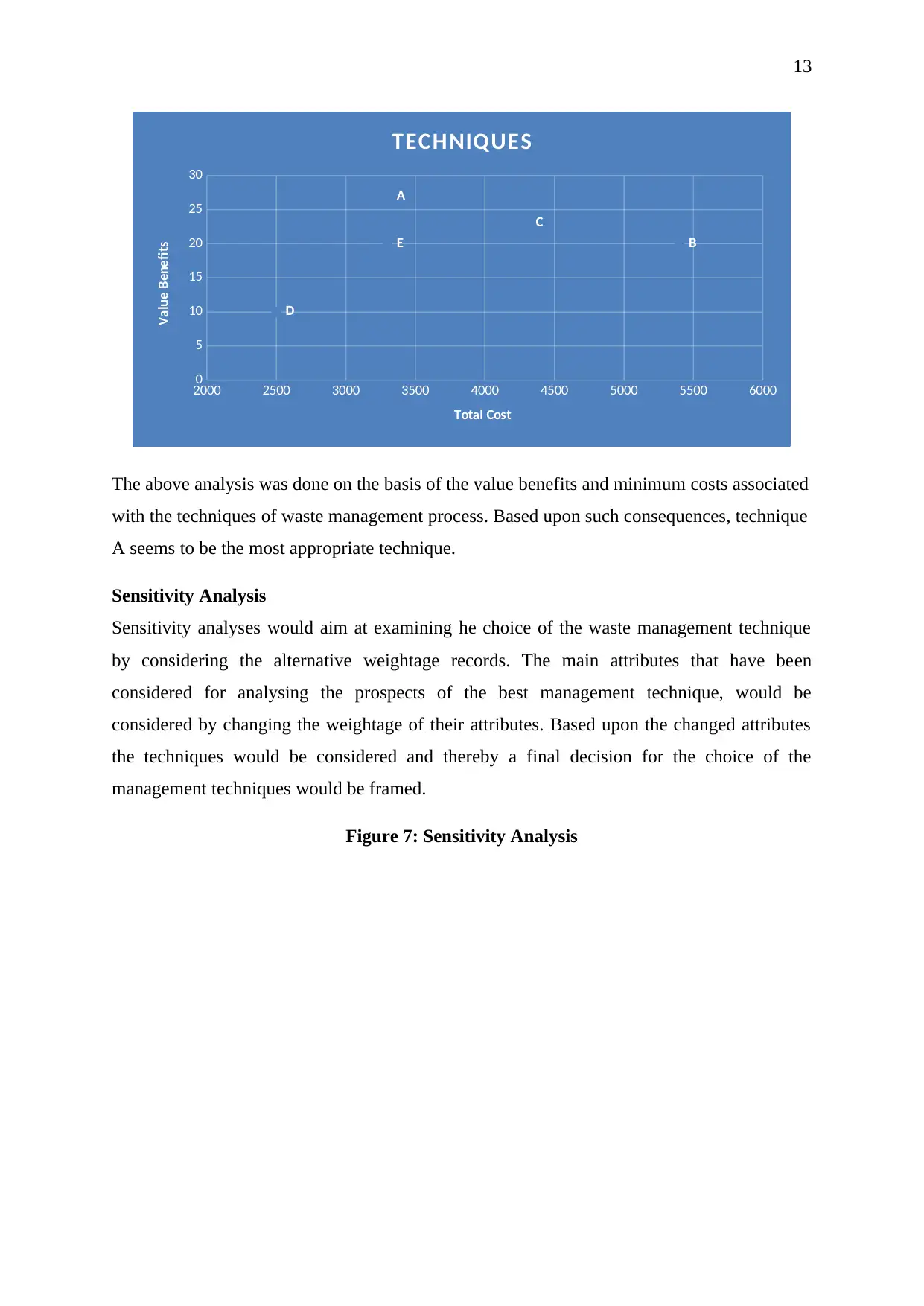
13
2000 2500 3000 3500 4000 4500 5000 5500 6000
0
5
10
15
20
25
30
A
B
C
D
E
TECHNIQUES
Total Cost
Value Benefits
The above analysis was done on the basis of the value benefits and minimum costs associated
with the techniques of waste management process. Based upon such consequences, technique
A seems to be the most appropriate technique.
Sensitivity Analysis
Sensitivity analyses would aim at examining he choice of the waste management technique
by considering the alternative weightage records. The main attributes that have been
considered for analysing the prospects of the best management technique, would be
considered by changing the weightage of their attributes. Based upon the changed attributes
the techniques would be considered and thereby a final decision for the choice of the
management techniques would be framed.
Figure 7: Sensitivity Analysis
2000 2500 3000 3500 4000 4500 5000 5500 6000
0
5
10
15
20
25
30
A
B
C
D
E
TECHNIQUES
Total Cost
Value Benefits
The above analysis was done on the basis of the value benefits and minimum costs associated
with the techniques of waste management process. Based upon such consequences, technique
A seems to be the most appropriate technique.
Sensitivity Analysis
Sensitivity analyses would aim at examining he choice of the waste management technique
by considering the alternative weightage records. The main attributes that have been
considered for analysing the prospects of the best management technique, would be
considered by changing the weightage of their attributes. Based upon the changed attributes
the techniques would be considered and thereby a final decision for the choice of the
management techniques would be framed.
Figure 7: Sensitivity Analysis
Paraphrase This Document
Need a fresh take? Get an instant paraphrase of this document with our AI Paraphraser
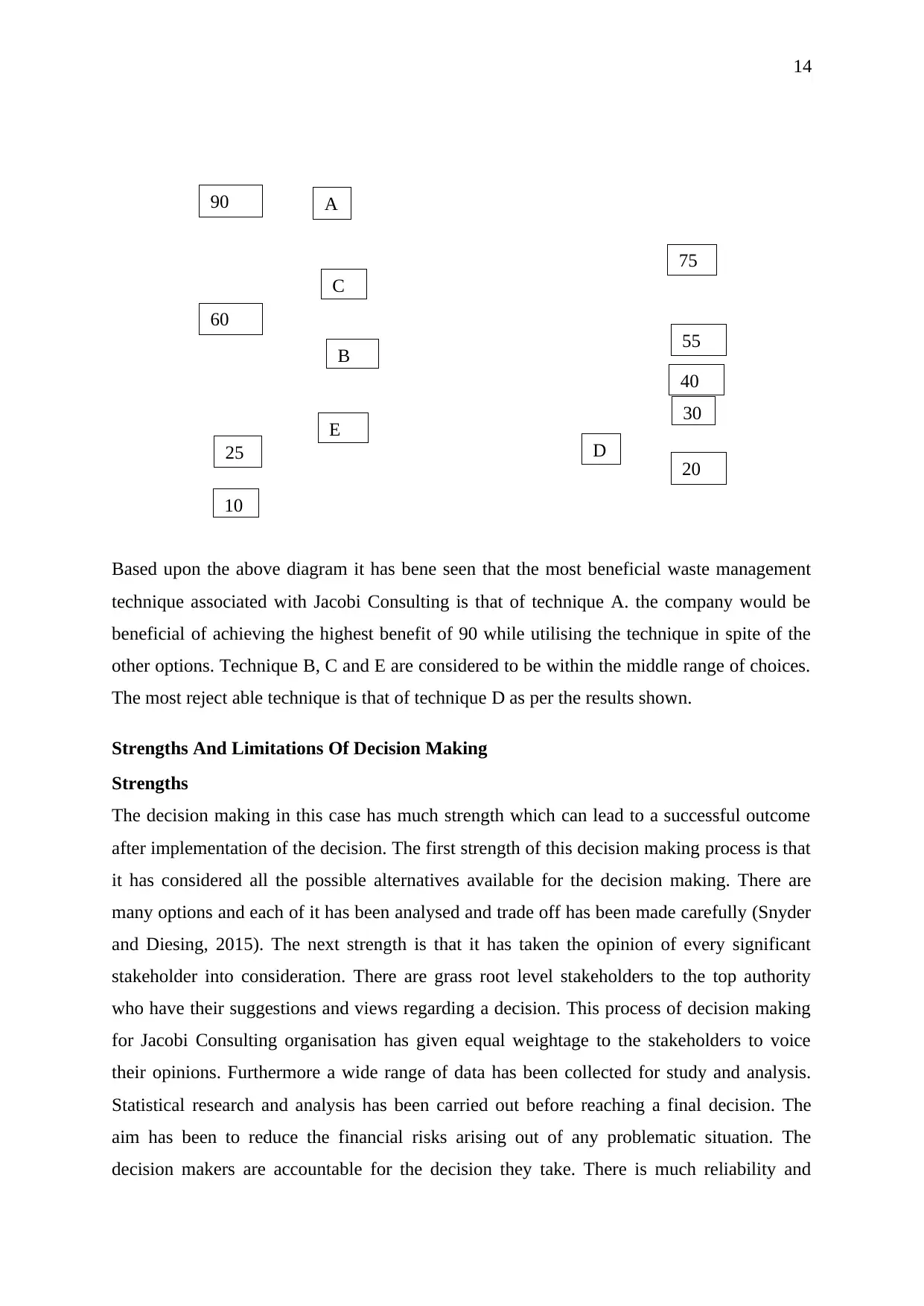
A
C
B
E
D
90
60
25
10
75
55
40
20
30
14
Based upon the above diagram it has bene seen that the most beneficial waste management
technique associated with Jacobi Consulting is that of technique A. the company would be
beneficial of achieving the highest benefit of 90 while utilising the technique in spite of the
other options. Technique B, C and E are considered to be within the middle range of choices.
The most reject able technique is that of technique D as per the results shown.
Strengths And Limitations Of Decision Making
Strengths
The decision making in this case has much strength which can lead to a successful outcome
after implementation of the decision. The first strength of this decision making process is that
it has considered all the possible alternatives available for the decision making. There are
many options and each of it has been analysed and trade off has been made carefully (Snyder
and Diesing, 2015). The next strength is that it has taken the opinion of every significant
stakeholder into consideration. There are grass root level stakeholders to the top authority
who have their suggestions and views regarding a decision. This process of decision making
for Jacobi Consulting organisation has given equal weightage to the stakeholders to voice
their opinions. Furthermore a wide range of data has been collected for study and analysis.
Statistical research and analysis has been carried out before reaching a final decision. The
aim has been to reduce the financial risks arising out of any problematic situation. The
decision makers are accountable for the decision they take. There is much reliability and
C
B
E
D
90
60
25
10
75
55
40
20
30
14
Based upon the above diagram it has bene seen that the most beneficial waste management
technique associated with Jacobi Consulting is that of technique A. the company would be
beneficial of achieving the highest benefit of 90 while utilising the technique in spite of the
other options. Technique B, C and E are considered to be within the middle range of choices.
The most reject able technique is that of technique D as per the results shown.
Strengths And Limitations Of Decision Making
Strengths
The decision making in this case has much strength which can lead to a successful outcome
after implementation of the decision. The first strength of this decision making process is that
it has considered all the possible alternatives available for the decision making. There are
many options and each of it has been analysed and trade off has been made carefully (Snyder
and Diesing, 2015). The next strength is that it has taken the opinion of every significant
stakeholder into consideration. There are grass root level stakeholders to the top authority
who have their suggestions and views regarding a decision. This process of decision making
for Jacobi Consulting organisation has given equal weightage to the stakeholders to voice
their opinions. Furthermore a wide range of data has been collected for study and analysis.
Statistical research and analysis has been carried out before reaching a final decision. The
aim has been to reduce the financial risks arising out of any problematic situation. The
decision makers are accountable for the decision they take. There is much reliability and
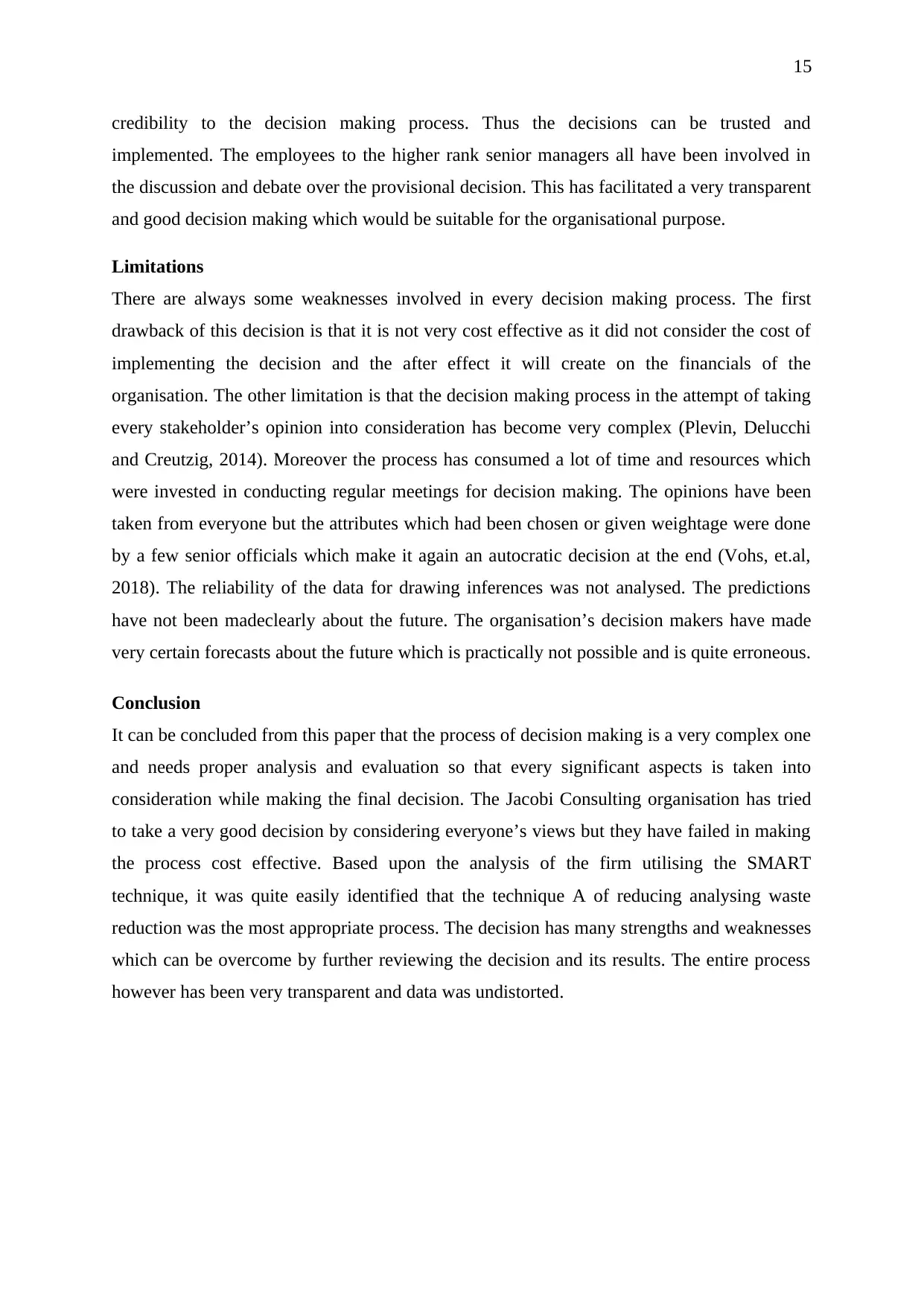
15
credibility to the decision making process. Thus the decisions can be trusted and
implemented. The employees to the higher rank senior managers all have been involved in
the discussion and debate over the provisional decision. This has facilitated a very transparent
and good decision making which would be suitable for the organisational purpose.
Limitations
There are always some weaknesses involved in every decision making process. The first
drawback of this decision is that it is not very cost effective as it did not consider the cost of
implementing the decision and the after effect it will create on the financials of the
organisation. The other limitation is that the decision making process in the attempt of taking
every stakeholder’s opinion into consideration has become very complex (Plevin, Delucchi
and Creutzig, 2014). Moreover the process has consumed a lot of time and resources which
were invested in conducting regular meetings for decision making. The opinions have been
taken from everyone but the attributes which had been chosen or given weightage were done
by a few senior officials which make it again an autocratic decision at the end (Vohs, et.al,
2018). The reliability of the data for drawing inferences was not analysed. The predictions
have not been madeclearly about the future. The organisation’s decision makers have made
very certain forecasts about the future which is practically not possible and is quite erroneous.
Conclusion
It can be concluded from this paper that the process of decision making is a very complex one
and needs proper analysis and evaluation so that every significant aspects is taken into
consideration while making the final decision. The Jacobi Consulting organisation has tried
to take a very good decision by considering everyone’s views but they have failed in making
the process cost effective. Based upon the analysis of the firm utilising the SMART
technique, it was quite easily identified that the technique A of reducing analysing waste
reduction was the most appropriate process. The decision has many strengths and weaknesses
which can be overcome by further reviewing the decision and its results. The entire process
however has been very transparent and data was undistorted.
credibility to the decision making process. Thus the decisions can be trusted and
implemented. The employees to the higher rank senior managers all have been involved in
the discussion and debate over the provisional decision. This has facilitated a very transparent
and good decision making which would be suitable for the organisational purpose.
Limitations
There are always some weaknesses involved in every decision making process. The first
drawback of this decision is that it is not very cost effective as it did not consider the cost of
implementing the decision and the after effect it will create on the financials of the
organisation. The other limitation is that the decision making process in the attempt of taking
every stakeholder’s opinion into consideration has become very complex (Plevin, Delucchi
and Creutzig, 2014). Moreover the process has consumed a lot of time and resources which
were invested in conducting regular meetings for decision making. The opinions have been
taken from everyone but the attributes which had been chosen or given weightage were done
by a few senior officials which make it again an autocratic decision at the end (Vohs, et.al,
2018). The reliability of the data for drawing inferences was not analysed. The predictions
have not been madeclearly about the future. The organisation’s decision makers have made
very certain forecasts about the future which is practically not possible and is quite erroneous.
Conclusion
It can be concluded from this paper that the process of decision making is a very complex one
and needs proper analysis and evaluation so that every significant aspects is taken into
consideration while making the final decision. The Jacobi Consulting organisation has tried
to take a very good decision by considering everyone’s views but they have failed in making
the process cost effective. Based upon the analysis of the firm utilising the SMART
technique, it was quite easily identified that the technique A of reducing analysing waste
reduction was the most appropriate process. The decision has many strengths and weaknesses
which can be overcome by further reviewing the decision and its results. The entire process
however has been very transparent and data was undistorted.
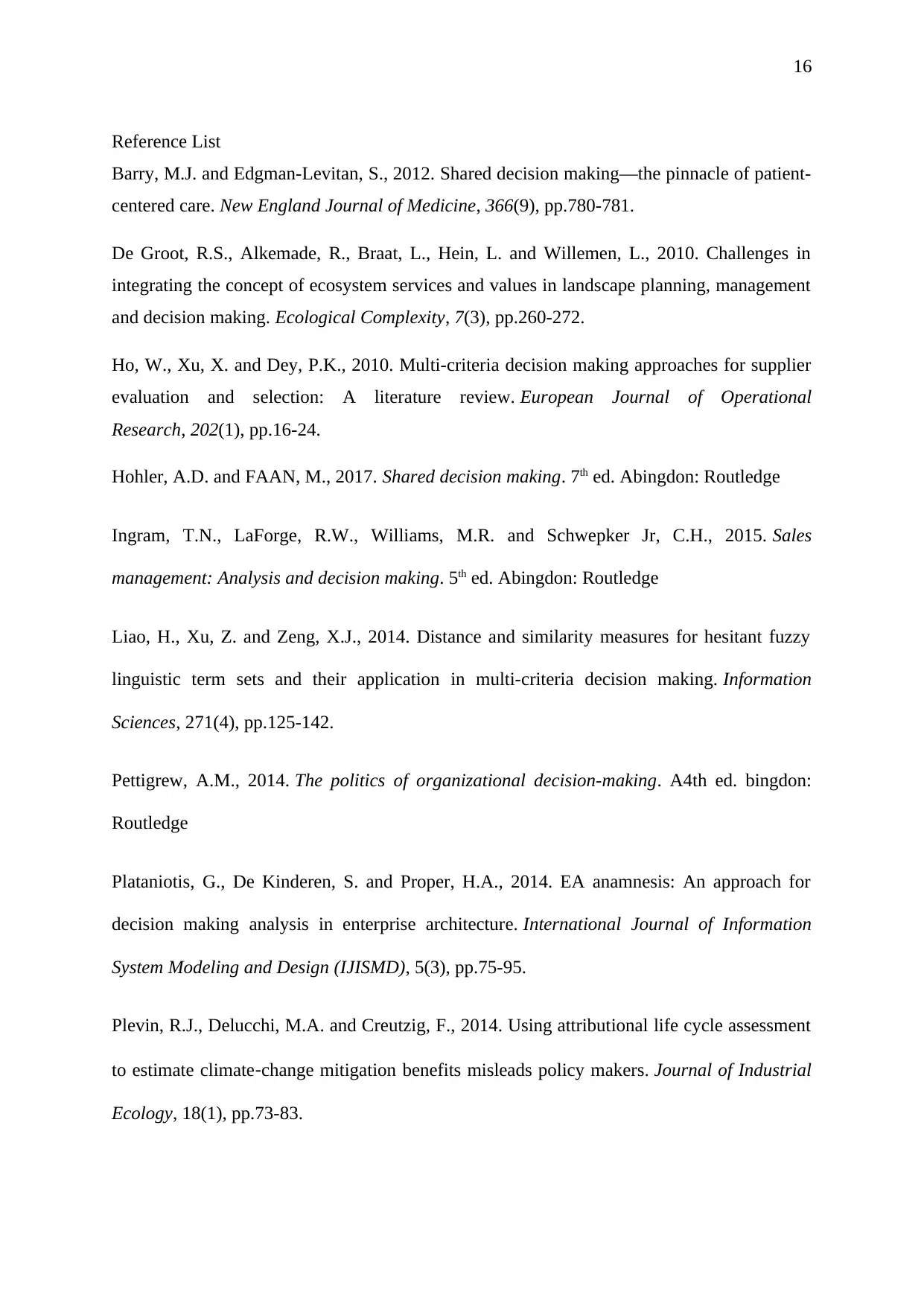
16
Reference List
Barry, M.J. and Edgman-Levitan, S., 2012. Shared decision making—the pinnacle of patient-
centered care. New England Journal of Medicine, 366(9), pp.780-781.
De Groot, R.S., Alkemade, R., Braat, L., Hein, L. and Willemen, L., 2010. Challenges in
integrating the concept of ecosystem services and values in landscape planning, management
and decision making. Ecological Complexity, 7(3), pp.260-272.
Ho, W., Xu, X. and Dey, P.K., 2010. Multi-criteria decision making approaches for supplier
evaluation and selection: A literature review. European Journal of Operational
Research, 202(1), pp.16-24.
Hohler, A.D. and FAAN, M., 2017. Shared decision making. 7th ed. Abingdon: Routledge
Ingram, T.N., LaForge, R.W., Williams, M.R. and Schwepker Jr, C.H., 2015. Sales
management: Analysis and decision making. 5th ed. Abingdon: Routledge
Liao, H., Xu, Z. and Zeng, X.J., 2014. Distance and similarity measures for hesitant fuzzy
linguistic term sets and their application in multi-criteria decision making. Information
Sciences, 271(4), pp.125-142.
Pettigrew, A.M., 2014. The politics of organizational decision-making. A4th ed. bingdon:
Routledge
Plataniotis, G., De Kinderen, S. and Proper, H.A., 2014. EA anamnesis: An approach for
decision making analysis in enterprise architecture. International Journal of Information
System Modeling and Design (IJISMD), 5(3), pp.75-95.
Plevin, R.J., Delucchi, M.A. and Creutzig, F., 2014. Using attributional life cycle assessment
to estimate climate‐change mitigation benefits misleads policy makers. Journal of Industrial
Ecology, 18(1), pp.73-83.
Reference List
Barry, M.J. and Edgman-Levitan, S., 2012. Shared decision making—the pinnacle of patient-
centered care. New England Journal of Medicine, 366(9), pp.780-781.
De Groot, R.S., Alkemade, R., Braat, L., Hein, L. and Willemen, L., 2010. Challenges in
integrating the concept of ecosystem services and values in landscape planning, management
and decision making. Ecological Complexity, 7(3), pp.260-272.
Ho, W., Xu, X. and Dey, P.K., 2010. Multi-criteria decision making approaches for supplier
evaluation and selection: A literature review. European Journal of Operational
Research, 202(1), pp.16-24.
Hohler, A.D. and FAAN, M., 2017. Shared decision making. 7th ed. Abingdon: Routledge
Ingram, T.N., LaForge, R.W., Williams, M.R. and Schwepker Jr, C.H., 2015. Sales
management: Analysis and decision making. 5th ed. Abingdon: Routledge
Liao, H., Xu, Z. and Zeng, X.J., 2014. Distance and similarity measures for hesitant fuzzy
linguistic term sets and their application in multi-criteria decision making. Information
Sciences, 271(4), pp.125-142.
Pettigrew, A.M., 2014. The politics of organizational decision-making. A4th ed. bingdon:
Routledge
Plataniotis, G., De Kinderen, S. and Proper, H.A., 2014. EA anamnesis: An approach for
decision making analysis in enterprise architecture. International Journal of Information
System Modeling and Design (IJISMD), 5(3), pp.75-95.
Plevin, R.J., Delucchi, M.A. and Creutzig, F., 2014. Using attributional life cycle assessment
to estimate climate‐change mitigation benefits misleads policy makers. Journal of Industrial
Ecology, 18(1), pp.73-83.
Secure Best Marks with AI Grader
Need help grading? Try our AI Grader for instant feedback on your assignments.
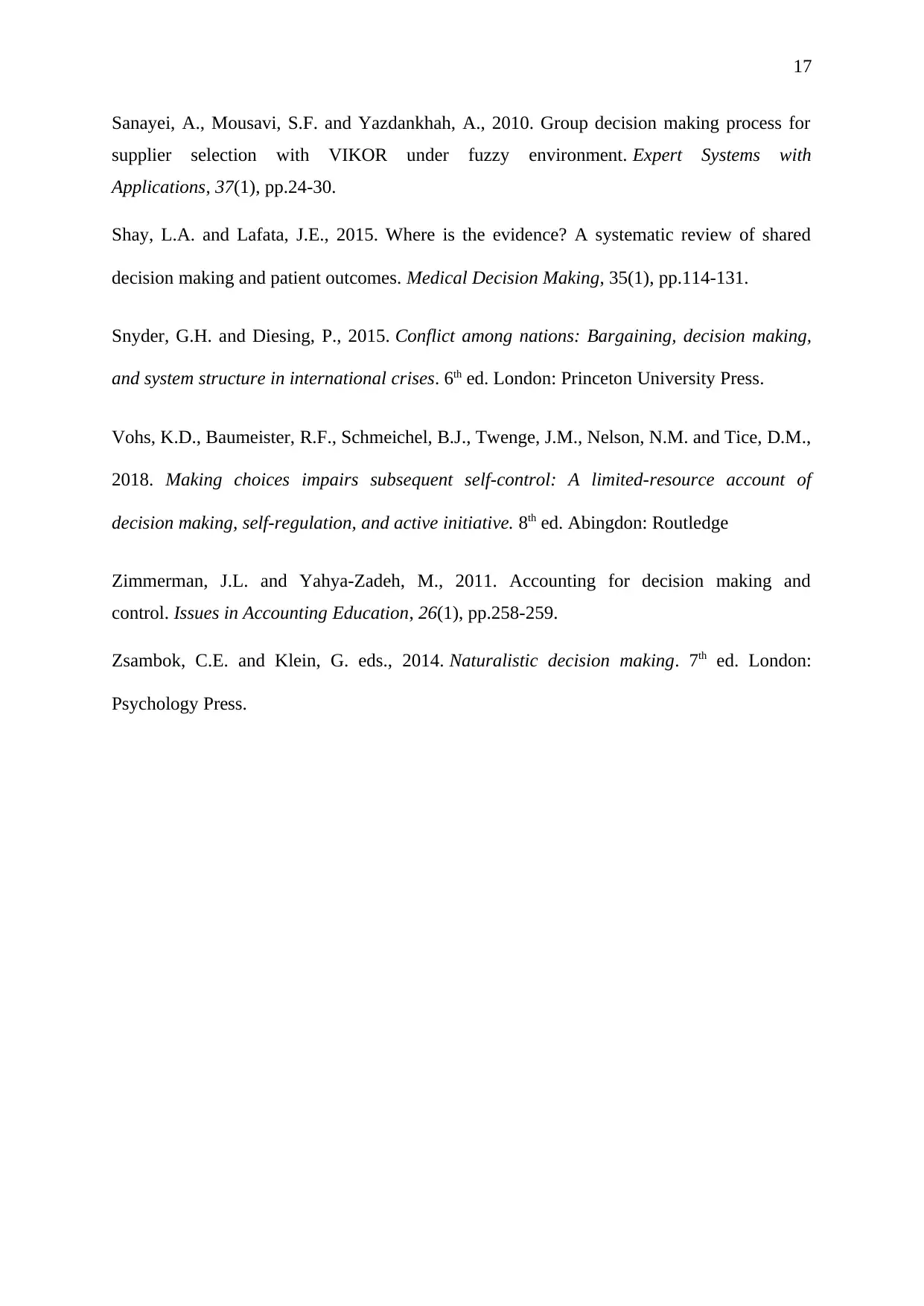
17
Sanayei, A., Mousavi, S.F. and Yazdankhah, A., 2010. Group decision making process for
supplier selection with VIKOR under fuzzy environment. Expert Systems with
Applications, 37(1), pp.24-30.
Shay, L.A. and Lafata, J.E., 2015. Where is the evidence? A systematic review of shared
decision making and patient outcomes. Medical Decision Making, 35(1), pp.114-131.
Snyder, G.H. and Diesing, P., 2015. Conflict among nations: Bargaining, decision making,
and system structure in international crises. 6th ed. London: Princeton University Press.
Vohs, K.D., Baumeister, R.F., Schmeichel, B.J., Twenge, J.M., Nelson, N.M. and Tice, D.M.,
2018. Making choices impairs subsequent self-control: A limited-resource account of
decision making, self-regulation, and active initiative. 8th ed. Abingdon: Routledge
Zimmerman, J.L. and Yahya-Zadeh, M., 2011. Accounting for decision making and
control. Issues in Accounting Education, 26(1), pp.258-259.
Zsambok, C.E. and Klein, G. eds., 2014. Naturalistic decision making. 7th ed. London:
Psychology Press.
Sanayei, A., Mousavi, S.F. and Yazdankhah, A., 2010. Group decision making process for
supplier selection with VIKOR under fuzzy environment. Expert Systems with
Applications, 37(1), pp.24-30.
Shay, L.A. and Lafata, J.E., 2015. Where is the evidence? A systematic review of shared
decision making and patient outcomes. Medical Decision Making, 35(1), pp.114-131.
Snyder, G.H. and Diesing, P., 2015. Conflict among nations: Bargaining, decision making,
and system structure in international crises. 6th ed. London: Princeton University Press.
Vohs, K.D., Baumeister, R.F., Schmeichel, B.J., Twenge, J.M., Nelson, N.M. and Tice, D.M.,
2018. Making choices impairs subsequent self-control: A limited-resource account of
decision making, self-regulation, and active initiative. 8th ed. Abingdon: Routledge
Zimmerman, J.L. and Yahya-Zadeh, M., 2011. Accounting for decision making and
control. Issues in Accounting Education, 26(1), pp.258-259.
Zsambok, C.E. and Klein, G. eds., 2014. Naturalistic decision making. 7th ed. London:
Psychology Press.
1 out of 17
Related Documents
Your All-in-One AI-Powered Toolkit for Academic Success.
+13062052269
info@desklib.com
Available 24*7 on WhatsApp / Email
![[object Object]](/_next/static/media/star-bottom.7253800d.svg)
Unlock your academic potential
© 2024 | Zucol Services PVT LTD | All rights reserved.





